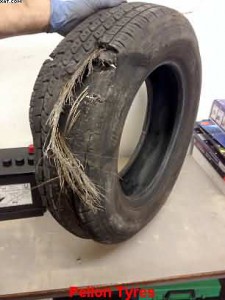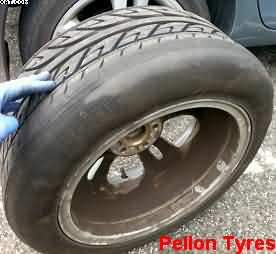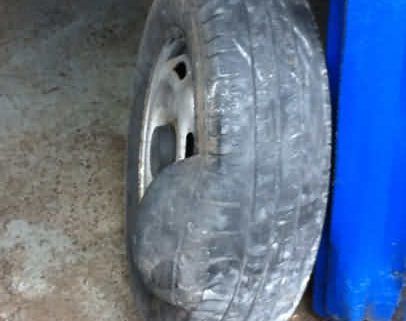Table of Contents
Tyre Separation
Tyre Separation
A Look At Tyre Separation

In all my years in the tyre business, this has always been a difficult thing to judge. One of the reasons is because the tyre often disintegrates into pieces and the original cause cannot be seen , at least with the naked eye.
I am bringing this up because just this week we have had two cases of tyre separation on two different types of vehicle.
One was a car, and the other was a caravan.
The car had developed a large “egg” on the shoulder area, and the caravan had pieces of tread hanging off after a blowout occurred when the driver was returning from his holidays.
Both of our customers were disgruntled, to say the least and both blamed the tyre separation on faulty tyres. More reading…http://www.tirefailures.com/coopertire/tirefailures.html
This takes me back to my younger days
When faulty tyres were very common. Even in my later years I noted that Firestone in America was having huge problems with tyres blowing out on the Ford Explorer.
The problem of the tyres became a mixture of blames as the SUV’s turned over after the tyre blowout occurred, but other problems with the vehicles design came into play, so I won’t go any further with that.
Tyre tread separation in the 1970’s
Tyre tread separation in the 1960’s and 70’s became a common thing.The problem stemmed from the tyre companies inability to design
and make a worthy steel belted radial to compete with the Michelin tyres, that were out classing all their other rivals in both quality and tyre mileage, the Michelin’s could double the mileage of all the other tyres on the market.
Goodyear and Firestone experimented with different types of steel to make the steel belt wires
But failed to stop the belts oxidising (rusting) and the oxygen that this gave off caused the tyres to separate. (Tyres are made of a build-up of different layers of rubber called a casing).
In the long run they were given a licence from Michelin and the secret of a steel belt coated with alloys made up of brass and copper resulted in the other tyre companies developing a better product, and virtually eliminating the tyre separation problem in their tyre products.
Another problem that let some of the tyre makers down was their lack of cleanliness. In the factories that produced the tyres. I can vouch for this myself, having visited some tyre factories and seen the dirt and dust everywhere.
In fact it has been known , over the years that things like screws and bolts, even a chicken bone and a screwdriver have been found embedded in a tyres structure, eventually giving the tyre owner problems.
The main problem in the past, though, has been dust and dirt
contaminating the adhesive that helps to vulcanise the tyre layers together. If dust gets in, then the tyre will eventually crack or start to form a bubble due to tyre separation. Other problems can be found with the steel belt. They can form rust and corrosion, which can be evidence that there has been some sort of moisture contamination during manufacture.
Tyre makers can now tell what a more specific problem may be. of moisture contamination during manufacturing. Bare wire is an indication of a manufacturing adhesion defect. Brassy wire is a strong indication that there has been an adhesive left out altogether.
These type of faults can now be detected by the use of high-resolution photographs.
These images can be taken of any exposed surfaces as quickly as possible after the problem has been discovered, especially if this is required as evidence in an accident case.
Tyre tread separation can be detected at an early stage
This is one of the dilemmas that we face when determining whether the fault lies with the tyre manufacturer or the customer.
The main thing is to make sure that you check your tyres at a regular basis, as well as check the pressure and look and feel for any sign of a small lump or bubble. I must admit that they are easy to see on the sidewall but not on the tread area.
The most common causes of these lumps and bumps on the sidewall are the tyre becoming kerbed, hitting a stone, or running over a pothole. One of the sidewall cords breaks, leaving a wet spot and pushing out the rubber to form a lump. If this happens and you detect it, then unfortunately, you will have to buy a new tyre.

The tread area is a little different.
I have found that the main problem for an egg to appear on the shoulder/tread area comes down to a previous puncture repair that the tyre has had. What happens is that the nail or screw, whatever you had in the tyre has damaged the wire in the steel belt and the tyre oxidises, just like a faulty new tyre does.
In 90% of cases an old puncture repair will be to blame and we are able to show the problem to the customer. If we cannot find anything that could have caused a problem then we will send the tyre back to the manufacturers with a suspected faulty tyre.
This is a bit of important advice. If you do go over a pothole or hit a kerb with you tyres bellow the pressure that they should be, then you will increase the chance of tyre damage.
Also if you feel that the car is pulling to the left or right
Subsequently, or your wheels are out of balance then this is an early sign of a separation problem in your tyre. Whenever a customer has a balancing problem, then the first thing we do is to examine the tyre for other problems.
Because it is most unusual for a tyre to go out of balance unless a wheel weight comes off, which is very rare. Therefore, it is likely that you will have another issue if you need the wheels balanced, and that issue is typically a slipped belt due to separation.
Pellon Tyres is a member of tyresafe.org
- SportContact 6-Continental tyres
- SEALANT Tyres From Kumho
- Slashed tyres-100 tyres slashed
- Canada Weather Tough Tyres
- Winter tyre market in Belgium

